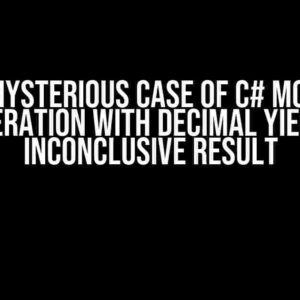Are you tired of dealing with tedious and error-prone pattern matching in your code? Do you want to take your coding skills to the next level by leveraging the power of exhaustive matches on Vector? Look no further! In this comprehensive guide, we’ll delve into the world of exhaustive matches and provide you with clear, step-by-step instructions on how to get the compiler to notice them on Vector.
What are Exhaustive Matches?
Before we dive into the nitty-gritty of getting the compiler to notice exhaustive matches on Vector, let’s take a step back and understand what exhaustive matches are.
In functional programming, pattern matching is a powerful tool that allows you to specify multiple alternatives for how to handle a piece of data. Exhaustive matches take this concept to the next level by ensuring that all possible cases are covered, leaving no room for errors or surprises. In other words, an exhaustive match is a pattern match that covers all possible values of a given type.
The Benefits of Exhaustive Matches
So, why should you care about exhaustive matches? Here are just a few benefits of using them in your code:
- Fewer errors**: By ensuring that all possible cases are covered, exhaustive matches reduce the likelihood of errors and runtime exceptions.
- Better code readability**: Exhaustive matches make your code more readable and maintainable, as they clearly outline all possible scenarios and their corresponding actions.
- Improved code quality**: By forcing you to think about all possible cases, exhaustive matches promote better code quality and design.
Getting the Compiler to Notice Exhaustive Matches on Vector
Now that we’ve covered the basics of exhaustive matches, let’s dive into the main event: getting the compiler to notice them on Vector.
Vector is a fundamental data structure in functional programming, and getting the compiler to notice exhaustive matches on it can be a game-changer for your code. So, how do you do it?
Step 1: Define Your Vector
The first step is to define your Vector. For the purposes of this example, let’s create a simple Vector of integers:
val myVector: Vector[Int] = Vector(1, 2, 3, 4, 5)Step 2: Write Your Pattern Match
Next, write a pattern match that covers all possible cases for your Vector. In this example, we’ll use a simple match statement:
myVector match {
case Nil => println("The Vector is empty")
case head +: tail => println(s"The Vector has $head as its head and $tail as its tail")
}Step 3: Add a Catch-All Clause
To get the compiler to notice your exhaustive match, you need to add a catch-all clause to your pattern match. This clause will catch any unexpected values that might slip through:
myVector match {
case Nil => println("The Vector is empty")
case head +: tail => println(s"The Vector has $head as its head and $tail as its tail")
case _ => throw new MatchError("Unexpected value")
}Step 4: Compile Your Code
Finally, compile your code and run it. If you’ve done everything correctly, the compiler should notice your exhaustive match and give you a warning or error if you’ve missed any cases.
Common Pitfalls and Solutions
While getting the compiler to notice exhaustive matches on Vector is a powerful tool, it’s not without its challenges. Here are some common pitfalls and solutions to keep in mind:
Pitfall 1: Forgetting the Catch-All Clause
If you forget to add a catch-all clause to your pattern match, the compiler won’t notice your exhaustive match. Solution: always add a catch-all clause to ensure that you’ve covered all possible cases.
Pitfall 2: Not Covering All Cases
If you don’t cover all possible cases in your pattern match, the compiler won’t notice your exhaustive match. Solution: take the time to think through all possible scenarios and ensure that your pattern match covers every eventuality.
Pitfall 3: Using Incomplete Patterns
If you use incomplete patterns in your match statement, the compiler won’t notice your exhaustive match. Solution: use complete patterns that cover all possible values of your Vector.
Best Practices for Exhaustive Matches on Vector
To get the most out of exhaustive matches on Vector, follow these best practices:
- Use explicit pattern matches**: Avoid using implicit pattern matches, as they can lead to errors and make it harder for the compiler to notice your exhaustive match.
- Keep your patterns simple**: Avoid complex patterns that can be hard to read and maintain. Instead, keep your patterns simple and easy to understand.
- Use type parameters**: Use type parameters to make your pattern matches more flexible and reusable.
- Test your code thoroughly**: Test your code thoroughly to ensure that it works as expected and catches all possible cases.
Conclusion
In this article, we’ve covered the benefits of exhaustive matches on Vector and provided step-by-step instructions on how to get the compiler to notice them. By following these guidelines and best practices, you can take your coding skills to the next level and write more robust, error-free code.
Remember, exhaustive matches are a powerful tool in your coding arsenal. By leveraging them on Vector, you can write more efficient, readable, and maintainable code that’s less prone to errors and surprises.
| Keyword | Definition |
|---|---|
| Exhaustive Match | A pattern match that covers all possible values of a given type. |
| Vector | A fundamental data structure in functional programming. |
| Catch-All Clause | A clause that catches any unexpected values that might slip through in a pattern match. |
Frequently Asked Question
Get the scoop on how to get the compiler to notice an exhaustive match on Vector – we’ve got the answers you need!
Q1: What’s the deal with the compiler not noticing my exhaustive match?
The compiler can be a bit finicky sometimes! When you’re dealing with vectors, the compiler might not notice an exhaustive match if you’re not using the correct syntax or if your match statement isn’t properly covering all possible cases. Double-check your code and make sure you’re using the `match` keyword correctly, and that you’re covering all possible variants of your Vector.
Q2: How can I ensure I’m covering all possible variants of my Vector?
One way to ensure you’re covering all possible variants is to use the `@` symbol to bind the remaining patterns. This tells the compiler that you’ve intentionally handled all cases and that any additional patterns should be caught by the `_` wildcard. For example: `match my_vector { | pat @ _ => … }`. This way, you can be confident that you’ve covered all your bases!
Q3: What if I have a large Vector and don’t want to write out all the possible patterns?
I feel you! Dealing with large Vectors can be a real pain. In this case, you can use the `..=` syntax to specify a range of values. This allows you to match on a range of indices, rather than having to write out each one individually. For example: `match my_vector { | 0 ..= 10 => … }`. This way, you can keep your code concise and focused on the logic at hand.
Q4: Can I use the `NonExhaustive` attribute to get the compiler to notice my match?
You’re on the right track! The `NonExhaustive` attribute is indeed used to indicate that a match is not exhaustive. However, this attribute should be used with caution, as it can suppress important compiler warnings. Instead, focus on writing a comprehensive match statement that covers all possible cases. If you’re still getting warnings, revisit your code and ensure that you’ve handled all possible variants.
Q5: What’s the best way to handle unexpected values in my Vector?
When dealing with unexpected values, it’s essential to have a solid plan in place. One approach is to use the `_` wildcard pattern to catch any unexpected values. You can then log an error or throw an exception to notify your team of the issue. Another approach is to use a separate `catchAll` branch to handle unexpected values. This way, you can ensure that your code is robust and can handle any unexpected surprises that come its way.


